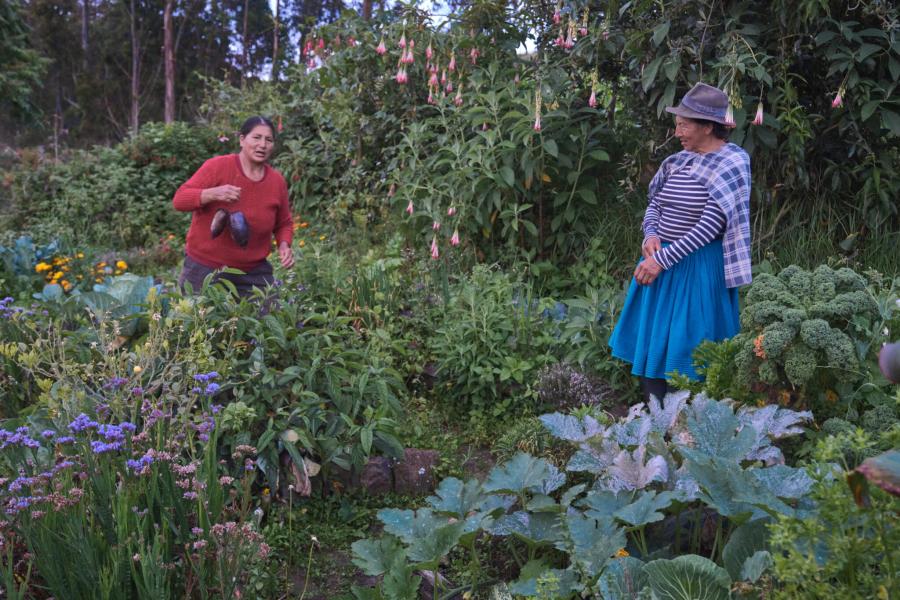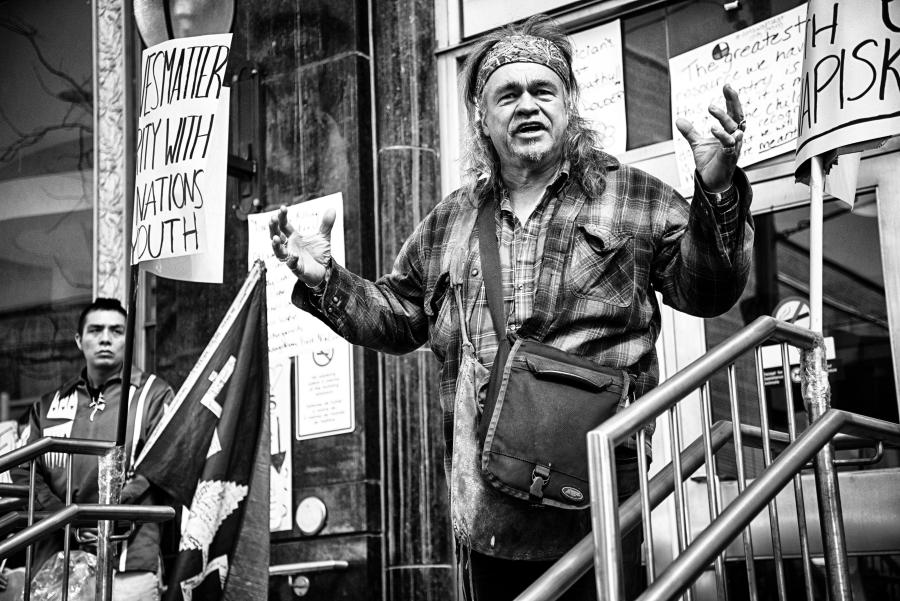Indigenous peoples are making their own spaces online, using art as the backdrop for cross-cultural dialogue.
Cyberspace—the websites, chat rooms, bulletin boards, virtual environments, and games that make up the internet—offers Aboriginal communities an unprecedented opportunity to assert control over how we represent ourselves to each other and to non-Aboriginals.
This article introduces the concept of Aboriginally determined territories in cyberspace and discusses how these can be defined, maintained, and expanded. We will do this within the Canadian context, though much of the discussion is pertinent to Aboriginal communities in other parts of the world. We draw on lessons learned from creating and curating CyberPowWow, an Aboriginally determined online gallery, to propose Aboriginal Territories in Cyberspace, a series of initiatives to expand Aboriginal presence online. These include expanding CyberPowWow into an ongoing community of new media artists addressing Aboriginal issues; developing Skins, a project in which elders work with youth to explore tribal stories through the use of online virtual environments; and laying the foundations for Within Reservations, which will function as a blueprint for equipping Aboriginals for full participation in the ongoing revolution in networked information technologies.
Terra Nullius: The Challenges of an (Almost) Blank Slate
History has shown us that new media technologies can play a critical role in shaping how Western, technologically oriented cultures perceive Aboriginals. The camera, for instance, taught people that we all wore headdresses and lived in teepees. Cinema claimed that we spoke in broken English—if we spoke at all. The World Wide Web has offered us the possibility to shape our own representations and make them known. Traditional mass media such as newspapers, magazines, television, and film are expensive to produce and distribute and consequently exclude Aboriginal peoples. On the internet, we can publish for a fraction of the cost of doing so in the old media; we can instantly update what we publish in order to respond to misrepresentations, misunderstandings, and misreadings; and we can instantly propagate our message across a world-spanning network. And we don't need to fight through any gatekeepers to do so.
Since its beginning, cyberspace has been imagined as a free and open space, much like the New World was imagined by the Europeans. In Neal Stephenson's novel Snowcrash, the as-yet-unclaimed areas of his cyberspace are portrayed as an ink-black nothingness awaiting the code that will turn them into useful virtual habitations. But if Aboriginal peoples learned one thing from contact, it is the danger of seeing any place as terra nullius, even cyberspace. Its foundations were designed with a specific logic, built on a specific form of technology, and first used for specific purposes (allowing military units to remain in contact after a nuclear attack). The ghosts of these designers, builders, and prime users continue to haunt the blank spaces.
The advent of the World Wide Web built on this foundation to create other levels, other rooms, entire other structures unimagined by the designers. This opportunity was available to anybody who had access to a computer, a network link, and the desire to learn HTML coding. It didn't include everybody, not by a long shot, but it took in far more people than had access to a television broadcast studio or a printing press. Among those who marshaled the necessary resources were a few Aboriginals who learned the programming technology necessary to build in the blank spaces. This was the beginning of the CyberPowWow.
Learning from CyberPowWow
The CyberPowWow project, conceived in 1996, is part website and part chatspace (www.cyberpowwow.net). Together, they form a virtual gallery with digital artworks and a library of texts. All the works have been created specifically for CyberPowWow. The site's main goals have been to overcome stereotypes about Aboriginal people; to help shape the World Wide Web; and to generate critical discourse—both in person and online—about First Nations art, technology, and community.
The first CyberPowWow exhibition declared our intention to be full participants in the ongoing evolution of cyberspace. As like-minded people (Aboriginal contemporary artists) separated by vast distances, we saw the internet as a valuable tool for community-building. Six Aboriginal artists and writers were invited to create work for the website. The launch of the exhibition was organized to be a simultaneous, distributed chat event (though we didn't know to call it that at the time). All the participating artists and writers, as well as the public at large, were asked to log on, at the same time, to a then-cutting-edge graphical chat space called the Palace (www.thepalace.com) where we could engage each other and visitors in discussion about the work on display. The event was successful in terms of the Aboriginal art and issues it brought into a public venue, but our critical dialogue was often interrupted by "non-participants" drifting in from other Palace chat rooms. It was clear that we needed to create a venue of our own.
CyberPowWow 2 was the launch of our very own Palace. Eight Aboriginal artists and writers customized the chat space with imagery, scripts, and a selection of Indian avatars (icons visitors selected to identify themselves in the space) available to the public. Artists presented their work and answered questions about it from an enthusiastic audience composed largely of people from the Canadian contemporary art community. While in one room artist Ahasiw Maskegon-Iskwew talked about his artistic process, Sheryl Kootenhayoo explained how to navigate through her Quicktime virtual reality piece, and Lori Blondeau led us all in a virtual round dance. During the two-day event, participants inevitably determined each other's geographical location, discovered who was wearing which avatar, and engaged in some mild flirtation all against a backdrop of brand new Aboriginal art.
By the third evolution, called CPW 2K: CyberPowWow Goes Global, we had answered the question: Can Native artists make digital art? Of course we could. We now felt strong and secure in our own territory, and it was time to widen our circle. From the start, artists from both Canada and the United States were part of CyberPowWow. We decided to invite Australian artists, whose colonial history and artistic concerns were so similar to ours in North America. And, for the first time, we asked non-Native artists to participate. "Now that we have marked out our territory, built a Palace and furnished it, it is time to invite in our neighbours: digital artists in the non-Native world,” Skawennati Tricia Fragnito wrote in her curatorial essay. “These friends, collaborators, and kindred spirits can talk about the very topic that we are engendering: Aboriginal meets non-Aboriginal."
Many non-Native people are invested in Native issues. Among those who joined us were the white feminist researcher Mare Burgess, who studies Indian warrior women, and white artist Sheila Urbanoski, who grew up in a town that bordered a reserve. Many Native people are also connected to non-Native people. Jason Lewis is a Cherokee adopted by a White family as a baby. Unfortunately, there are not many places to talk about these relationships. CyberPowWow is a safe space for these discussions.
Expanding the Boundaries
Now we are drawing on the CyberPowWow experience to further leverage the power of networked technologies to stake out even more territory. The next phase of CyberPowWow will see it transformed from a site built around biannual exhibitions to an ongoing, online, Aboriginally determined, artist-run center with solo exhibitions and thematic group shows. Aboriginal Territories in Cyberspace (AbTeC) expands the CyberPowWow model even further, and seeds two other related initiatives, Skins and Within Reservations.
• Skins aims to empower youth by fostering a greater knowledge and pride of their own history. It provides a medium to convert that knowledge from one storytelling format to another in the interest of maintaining it. Game "modding" is the term used to describe adapting or creating game content using commercial game engines. Modders are able to leverage the technical infrastructure of a game to create their own fully functional yet fully personalized game worlds. AbTeC has taken another word for this practice, "skinning," as inspiration for a project that will bring together Mohawk teenagers and tribal elders from the Kahnawake First Nation in Quebec. In Skins, they will work in small teams, with the teens interviewing the elders about tribal history and using those interviews to build virtual, navigable spaces to represent and illustrate the stories.
Skins encourages teens to embrace computer technology as a means of creative expression and production, not just consumption. Finally, it gives teens an introduction to computer programming to use as a foundation for making the computer a tool which they can fully control and exploit.
• Within Reservations will promote the training of Aboriginal youth in programming and software design, and encourage them to open software design consulting firms based on those skills. We have long thought that reservations, many of which are remote and poor in natural resources, would be ideal places in which to site such firms. Distance matters less and less in this business, and the only resources required are electricity and connectivity. Within Reservations will build upon the foundation laid by Skins by encouraging the same students to advance their programming and media creation skills even further.
We are confident that the lessons learned from CyberPowWow will prove useful in building new Aboriginal territories through which Native people can illustrate their stories to each other and to non-Natives. We are excited about these possibilities, and we invite members of other Aboriginal communities to come visit us, out where we are filling in the blank spaces.
Skawennati Tricia Fragnito is a Mohawk artist, writer, and independent curator whose projects have included CyberPowWow (www.CyberPowWow.net), a virtual gallery and chat space, and Imagining Indians in the 25th Century (www.ImaginingIndians.net), a web-based paper doll/time-travel journal. In 1994, Skawennati co-founded Nation to Nation, a First Nations artist collective whose goals were to create an outlet to show members’ work, and to foster a safe meeting space for Natives and non-Natives. Jason Lewis, Cherokee, is assistant professor of computation arts in the Department of Design and Computation Arts at Concordia University, Montreal, Quebec. He maintains a thriving art practice as well as a research practice, both of which are founded on computational approaches to digital media. He is the founder and director of Obx Laboratory for Experimental Media (www.obxlabs.net).



